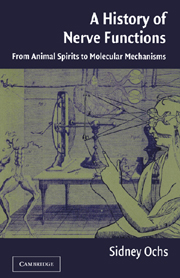Book contents
- Frontmatter
- Contents
- Preface
- 1 Introduction: Greek Science and the Recognition of Nerve as a Channel
- 2 Galen's Physiology of the Nervous System
- 3 Nerve, Brain, and Soul in the Middle Ages
- 4 Renaissance and the New Physiology
- 5 New Physical and Chemical Models of Nerve in the Enlightenment
- 6 New Systematizations of Nerve Function in the Enlightenment
- 7 Electricity as the Agent of Nerve Action
- 8 Nerve Fiber Form and Transformation
- 9 Wallerian Degeneration: Early and Late Phases
- 10 Nerve Regeneration
- 11 Characterization of Axoplasmic Transport
- 12 Molecular Models of Transport
- 13 Actions of Neurotoxins and Neuropathic Changes Related to Transport
- 14 Purposeful Reflexes and Instinctive Behavior
- 15 Neural Events Related to Learning and Memory
- 16 Epilogue: With Observations on the Relation of the Nervous System to Mind
- Bibliography
- Index
10 - Nerve Regeneration
Published online by Cambridge University Press: 13 August 2009
- Frontmatter
- Contents
- Preface
- 1 Introduction: Greek Science and the Recognition of Nerve as a Channel
- 2 Galen's Physiology of the Nervous System
- 3 Nerve, Brain, and Soul in the Middle Ages
- 4 Renaissance and the New Physiology
- 5 New Physical and Chemical Models of Nerve in the Enlightenment
- 6 New Systematizations of Nerve Function in the Enlightenment
- 7 Electricity as the Agent of Nerve Action
- 8 Nerve Fiber Form and Transformation
- 9 Wallerian Degeneration: Early and Late Phases
- 10 Nerve Regeneration
- 11 Characterization of Axoplasmic Transport
- 12 Molecular Models of Transport
- 13 Actions of Neurotoxins and Neuropathic Changes Related to Transport
- 14 Purposeful Reflexes and Instinctive Behavior
- 15 Neural Events Related to Learning and Memory
- 16 Epilogue: With Observations on the Relation of the Nervous System to Mind
- Bibliography
- Index
Summary
Just as broken bones can heal, so must it have seemed possible to the ancients that cut nerve could reunite and its function restored. Ancient authority is silent on this, but although not stating it explicitly, Galen's commentators in the Middle Ages suggested that he thought this to be so because of the prescriptions he gave for the treatment of nerve wounds that were aimed to bring about the “agglutination” of cut nerves. Paul of Aegina (seventh century) apparently followed Galen in using medications to promote agglutination, also mentioning suturing of divided nerves:
After the exposed nerve has been covered over, we must apply externally pledglets, with some of those things which are fitting for narrow wounds, such as that from euphorbium, or that from pigeon's dung, taking in also much of the sound parts. When the wound is transverse there is greater danger of convulsions, but everything relating to the cure is in this case the same, except that while the wound is recent some have used sutures and certain of the agglutinative applications; but the sutures must not be applied very superficially lest the part below remain ununited, but more deeply, taking care however that the nerve be not punctured by the needle. It is to be known once for all, that in wounds of the nerves the medicine which cures punctures being of a bitter nature, it is not possible to cure with it the division of the nerve, as the parts cannot endure pungency and inflammation. […]
- Type
- Chapter
- Information
- A History of Nerve FunctionsFrom Animal Spirits to Molecular Mechanisms, pp. 187 - 214Publisher: Cambridge University PressPrint publication year: 2004



